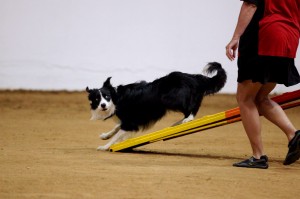It’s so easy to moan and groan that we don’t get the same performance from our dog in a trial as we do in training, yet there is likely something we’re doing (different body language, stress, lack of a release cue, etc.) that’s affecting our dog’s trial performance. Continued training at home and in class will definitely help, but it doesn’t assimilate the same adrenaline rush as a trial situation does. Fun matches can also help, but they’re unfortunately few and far between, and handlers are usually not in the same mental/emotional state as they are in a real trial.
I’m happy with how I initially trained Braedan’s 2-on/2-off contact performance, and he’s pretty consistent about maintaining the criteria in training. Trials, however, are a different story. Braedan gets so gee

ked up and can’t wait to get to the next obstacle (especially if the next obstacle is a tunnel!), so his performance often deteriorates in a trial situation. Like most of us agility handlers, I’m also pretty excited when running a course at a trial, so I confess
I’m not 100% consistent about insisting Braedan stop at the bottom of his contacts each and every time and then wait for his release word. It’s no wonder, then, that poor Braedan really doesn’t know what I want.
To help both me and Braedan work on his contact performance, I entered one day of an ASCA trial (because ASCA will allow you to train in the ring). It was perfect because it was a real trial, so Braedan was high as a kite like he usually is when at a trial. We were able to work our contacts in four of our five runs of the day, and the experience clearly showed me that I need to do more proofing in our training. I’ve also decided I need to enter another ASCA trial (or two or three ;-)) to test Braedan in a real trial situation while still being able to train if necessary.
Here are the runs from the ASCA trial. You can see that, even though Braedan was hitting his contacts (and was therefore not faulted by the judge and in fact earned points in the two Gamblers classes), his performance was often not what I wanted, which is for him to stay put in the 2-on/2-off position until I give him his release word. You can also see how having a tunnel at the end of a contact affects Braedan (yep, he loves his tunnels). In our last run of the day, there was definitely some improvement, but it’s obvious we’re not “there” yet.
We’ve still got more work to do, Baby Brae. 🙂


